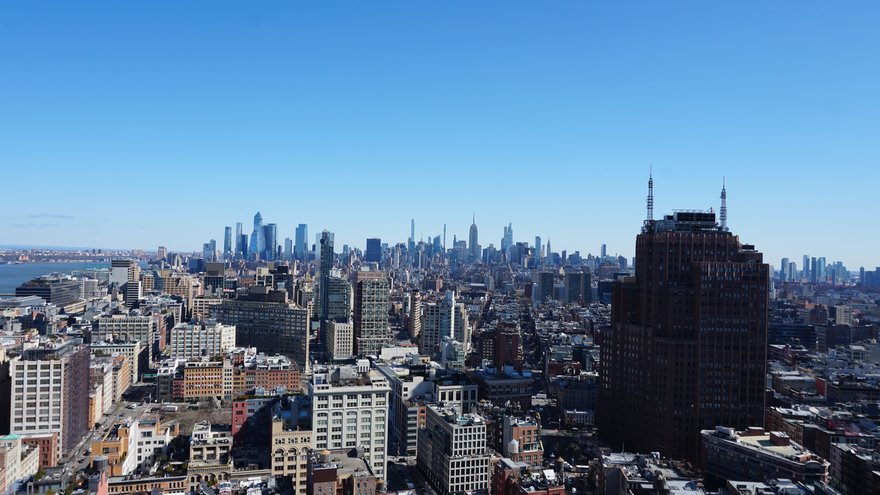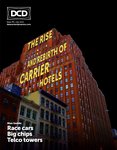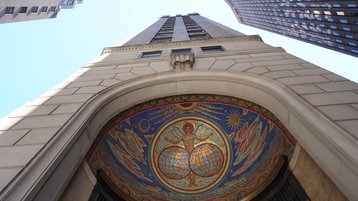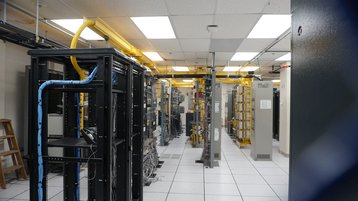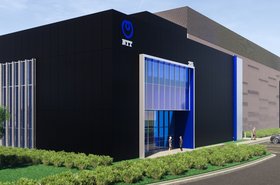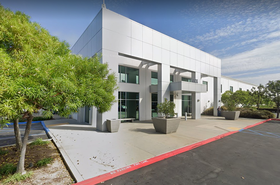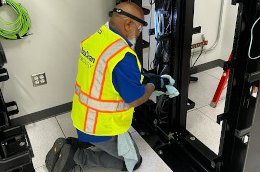Most major metropolises in North America will have two, perhaps three major carrier hotels. Some tier two cities will have one such facility, while many more will have none at all.
New York, however, boasts more densely-networked carrier hotels than the total number of data centers in some other cities. Thanks to New York’s population density, the presence of a major global financial district, its location as an East Coast cable landing hub, and strong historical connections to AT&T and its Bell predecessors, the area is rife with communication infrastructure.
The NYC Trifecta
Today 60 Hudson Street and 32 Avenue of the Americas (32 AotA) are the twin centers of the connectivity ecosystem in NYC, though most would likely say 60 Hudson is the heart of the Internet there and perhaps even the world.
Both located in Tribeca, the two Art Deco buildings were designed by Ralph Thomas Walker of Voorhees, Gmelin & Walker.
Other notable buildings the firm designed for communications companies include the Barclay-Vesey Building at 140 West Street (originally for New York Telephone, and today home to its successor Verizon Communications); 101 Willoughby Street, also for New York Telephone; and the New Jersey Bell Headquarters Building at 540 Broad Street in Newark, New Jersey.
The 24-story 60 Hudson was built between 1928 and 1930 for use as telegraph company Western Union’s headquarters and designed to be ‘the largest telegraph building in the world’ and the ‘Telegraph Capitol of America.’ The company sold the building in the 1940s but continued to occupy the site until the 1980s, when it relocated to New Jersey, with the building becoming an AT&T telecoms hub.
Pneumatic tubes ran the length of the building to carry telegrams and other mail. They eventually became filled with copper, and later, fiber. Some joke that if you remove the bricks, the copper and fiber conduits could support the building. Today the facility has more than 100 carriers present.
The facility is now owned by Stahl-affiliated 60 Hudson Street LLC and managed by Colliers. HudsonIX, Digital Realty, NYI, DataBank are among some of the building’s tenants.
Five hundred yards away, 32 Avenue of the Americas was built in phases from 1911 with the final construction work between 1929 and 1932. 32 AotA was built for AT&T and known as the AT&T Long Lines Building. The property spans more than one million sq ft; at one point, every Bell System trunk line in the Northeastern United States converged within the building.
The 27-story building remained under the telco’s ownership until the eve of the new millennium, with the privately held Rudin Management Company buying it in 1999 and still owning it today. The site has more than 50 carriers; colo tenants include Digital Realty and CoreSite.
A mile and a half North, 111 8th Avenue was for many years the third part of what was known as the NYC Trifecta. The 15-story structure, previously known as the Port Authority Building, spans 2.9 million square feet of floor space. However, today its status as a core data center connectivity hub is weakening.
Another Art Deco building completed in 1932, it was originally used as a terminal to transport goods by truck to and from railroad lines and shipping piers on the Hudson River. The Port Authority sold the building to Sylvan Lawrence Company-affiliated Realopco Inc. for $24 million in July 1973.
It was sold again in 1997 to Blackacre Capital Group and Taconic Investment Partners for $387 million and marketed to telecoms and Internet firms. After building up a sizeable roster of carriers, Google acquired the site in 2010 in a deal reported to be worth around $1.8 billion.
Today Digital Realty has a space in this facility, which it acquired from Telx in 2015. Equinix, DataBank, and Colocation America are also present in the building.
However, a number of firms have left the facility in the intervening years; at the time of its acquisition Google reportedly planned to “gobble up” other tenants’ space in the building.
“It’s not about the ‘carrier hotel’ space,” Google's SVP of Product Management, Jonathan Rosenberg, said of the acquisition in 2011. “We have 2,000 employees on-site...[and] it’s very difficult to find space in New York.”
One local industry insider told DCD the NYC market was “shrinking day by day as Google continues to add food trucks instead of data center space” in the building. Now-bankrupt Internap left the building in 2013 to relocate to New Jersey.
On its website, H5 DC says: “Google has shown more interest in constructing office and commercial space at 111 8th Avenue than in growing the interconnection community. Over time, 111 8th Avenue is expected by many experts to not serve any carrier-neutral data center requirements.
“We recommend that all prospective customers steer clear of 111 8th Avenue due to the lack of surety as a long-term data center location. Existing customers would be wise to have a contingency plan when/if Google management would like to convert data center space to an alternative commercial use.”
NYC’s ring of carrier hotels
In the years since Google's acquisition of 111 8th Avenue, a number of new facilities popped up or expanded, hoping to take the building’s crown as the third major hub in New York.
Telehouse America acquired a 60,000-square-foot facility in 2011 that was previously a Lehman Brothers data center at 85 10th Avenue. The building itself, built on a former landfill in 1939 for Nabisco, was reportedly where the first Oreos were made.
Level 3 bought the building in 1998 and sold it to Somerset Partners in 2005, and it was sold again in 2007 to current owners Related Companies & Vornado Realty Trust.
Like 111 8th Avenue, however, Google is a major office tenant of the property.
365 Data Centers – then 365 Main – announced it was to double space at its 65 Broadway facility in 2013. Owned by the Chetrit Group and formerly the American Express Building, the site offers a 16,000 sq ft data center with ten carriers present. Built around 1917 and spanning 21 floors, 365 took over a Switch & Data facility there from Equinix in 2012.
Sabey has been operating 375 Pearl Street – also known as Intergate.Manhattan – since 2013. Completed in 1975 for the New York Telephone Company, Verizon sold the building in 2007 to Taconic Partners, but its logo is still visible on the tower. Sabey acquired the property in 2011 from M&T bank in lieu of foreclosure.
Offering access to more than 15 network providers, around seven of the 32 floors are dedicated to data center space, with another four for generators, chillers, and other infrastructure.
H5 also operates a 240,000-square-foot data center in the city at 325 Hudson. Atlantic Metro, which was acquired by 365 DC in 2020, operated a data center in the building since 2007. Global Cloud Xchange was also present in the building.
Built in the 1950s as a manufacturing facility and converted to data center use around the year 2000, DivcoWest acquired the ten-story building in 2021 for $135 million, after which H5 moved in. The building has access to more than 40 fiber networks.
Many others have come and gone over the years. Atlantic Metro opened a 5,000 sq ft facility at 121 Varick Street in 2010 that is no longer in operation. Atlantic, alongside Data Center NYC Group, aimed to convert at least seven floors of the 12-story SoHo building into a data center hub in a $100 million phased build-out. ColoHouse-owned Steadfast Networks was also a tenant.
Telehouse opened a data center at 25 Broadway in 1997 that it has since exited. The site was built in 1919 for the Cunard White-Star Line shipping company; Telehouse offered 85,000 square feet across two floors.
Cogent still lists a data center at 25 Broadway on its website, but has exited 33 Whitehall. Datagram – acquired by Singlehop, which was then bought by Internap – had also been previously present at 33 Whitehall since 2004.
The Starrett–Lehigh Building, a 19-story building at 601 West 26th Street, was another property designed to be a port terminal when it opened in 1931.
Broadview (acquired by Windstream), Lexent Metro Connect (acquired by Crown Castle’s Lightower), Level 3 and others previously operated data centers in the building.
Built in 1960 by Rudin, 80 Pine once housed a Global Crossing data center. The company was acquired by Level 3 in 2011.
Global Crossing had a facility in 110 East 59th Street – a modern glass structure from the late 60s.
Looming in the background, there is also 33 Thomas Street – a giant, windowless, 1970s brutalist AT&T building known by the NSA as Titanpointe. While it is nominally a telephone exchange building, it is known to be a US government surveillance hub.
811 Tenth Avenue is another ‘60s brutalist windowless AT&T switching building in the city.
75 Broad is reborn
For many years, 75 Broad Street was one of the more notable carrier hotel data centers in NYC. But like many others in the city, the building came close to losing all its data center tenants.
As with a number of the mentioned buildings in this piece, 75 Broad has telecoms pedigree. Built in 1929, it was the former headquarters of the International Telephone and Telegraph Company.
During World War II, it served as a hub for communications with American submarines operating in the Atlantic Ocean. Like many other buildings in the city, it was converted to telecoms use in the early 2000s. At its peak, it boasted a healthy number of data center providers including Internap, FiberMedia/VxChnge, and Peer 1.
“This building has a long storied history as a carrier hotel that fell apart during Sandy because they really got clobbered,” says Phillip Koblence, COO at local data center firm NYI.
In 2012, Hurricane Sandy caused huge amounts of damage across the eastern seaboard. The Atlantic hurricane was one of the largest on record, and flooded a large part of downtown Manhattan, knocking out power across parts of the city for more than a week.
In terms of digital infrastructure, 75 Broad was one of the hardest hit sites in the city; the basement was flooded under more than 15 feet of water. Due to regulations enacted after 9/11, New York data centers keep their diesel fuel in the basement, and their generators on the roof. Floodwater damaged the diesel fuel pumps, leaving providers no way to refuel generators on mezzanine floors.
Internap's data center at the building (known as LGA11) was knocked offline by the incident, and was only brought back online once a fuel truck arrived.
Peer 1 managed to stay online, but only through its now-legendary bucket brigade. Staff, along with customers including Squarespace, manually carried diesel fuel up 17 stories from the street to the rooftop generator. At first, they tried to carry 55-gallon diesel drums on hand trucks one flight at a time. Eventually, the diesel was transferred into smaller five-gallon barrels and carried upstairs in a chain for some sixty hours.
Other facilities impacted and unable to stay online were Atlantic Metro’s 325 Hudson Street and 121 Varick Street, Datagram at 33 Whitehall, Verizon at 140 West Street, and Internap & Equinix at 111 8th Avenue due to generator failures.
In the wake of Sandy, 75 Broad’s decline wasn’t instant, but happened slowly over the years as customers and colo providers left the facility. The now-shutdown VxChnge – previously FiberMedia Group – was the last to leave. Many moved to New Jersey.
“New York's infrastructure, from the standpoint of people's feelings about how resilient it was, it took a significant hit,” says Koblence. “Anybody that was on the fence about moving to the cloud or whether this city was where you should deploy a significant amount of your production environment, their case was made to migrate out to other places.”
Real estate firm JEMB acquired the 34-story, 720,000-square-foot property in 1999. After all the operators left, the last remaining data center facility at 75 Broad ended up being taken over by building ownership.
In 2021, BSC announced it was selected to provide critical facility management for a data center formally operated by FiberMedia Group LLC at 75 Broad.
According to Koblance, building ownership came to NYI and said it had a data center asset at 75 Broad it was running for some legacy customers.
“They said we have some interconnection that is incredibly difficult for those companies to reprovision or move because it's just been here for so long, is there a way for us to take that infrastructure and make it relevant again?”
As a result, NYI is now JEMB’s operating partner for 75 Broad in a deal focused on “re-establishing 75 Broad Street as an interconnection hub.” JEMB has reportedly invested more than $15 million in the building since 2012.
NYI will act as a strategic operating partner, managing the sales, business development, marketing, and customer success functions for digital infrastructure and interconnection activities at 75 Broad Street. As well as attracting enterprises, the goal is to lure more carriers to the building.
“A lot of the investment that JEMB made in this building – flood gates, hardened power infrastructure, etc – they made because of the acute impact of all of what happened during Sandy,” he says. “Those investments haven't been made in other buildings that weren't as impacted.”
“What never changed and was never decommissioned though is that fiber ecosystem that existed here. That's something that's really really difficult to recreate.”
Koblence says his aim is to make 75 Broad relevant again and lend its company’s data center credentials to the facility's sizeable interconnectivity assets.
“I don't know this building will ever be the place where you're going to build large data centers again, and I don't know that New York City is necessarily a place where you're going to build large, multi-megawatt data centers.
“But the fiber’s here, and it's inherently relevant because - for all of the compute infrastructure that has moved to the Midwest and Dallas and Ashburn - at the end of the day, the NFL cities are still the places where the eyeballs are. All that data has to exist somewhere and it's just not efficient for it to all happen at some aggregated site in Ashburn, which is why New York has evolved into an interconnection-focused city.”
NYI was founded in the mid-1990s and co-founder Koblence has seen the NYC data center market change over the years as it toured various facilities in the city. The company started offering hosting, web development, and DSL services. It originally offered services out of 20 Exchange Place, another 1930s art deco building formerly known as the City Bank-Farmers Trust Building.
“We originally started just next to PennStation on 29th and 7th and we moved downtown, put in some racks, and ripped up the carpet,” says Koblence.
NYI then migrated to a 2MW data center at 100 Williams Street in a site Level 3 had been building out but decided not to use in the wake of 9/11. It remained there until 2020.
After the 2008 crash, the company then launched another site, 999 Frontier, in Bridgewater, New Jersey that had belonged to payroll company ADP. The company sold the site in 2019 to 365 DC, which still operates it today.
NYI moved into 60 Hudson in 2018 after acquiring Sirius Telecommunications’ assets at the iconic building.
“When we acquired the former Sirius Telecom site at 60 Hudson Street, it really was our introduction into the carrier hotel space and interconnection.”
Today the company is also building out further in 60 Hudson after taking over space recently exited by Equinix.
Brooklyn and Long Island want to muscle in
Outside of the city, the wider New York area is still blessed with more carrier hotels than most.
West of the Hudson River in New Jersey, Equinix operates its campus in Secaucus, while the Tishman-owned 165 Halsey Street offers 80MW across 1.2 million sq ft and access to some 60 carriers.
South of the East River, Brooklyn is one of the most populous and densely populated areas in the country. Located at 882 3rd Avenue in Brooklyn’s Industry City, DataVerge operates what it says is the borough’s only carrier-neutral meet-me room and carrier hotel.
The facility currently occupies 50,000 sq ft across two floors of the building, with another 35,000 sq ft immediately available as well as multiple currently-empty floors potentially offering hundreds of thousands of square feet. The facility offers connections to around 30 networks.
“We have this fiber here and now all those carriers aren't backhauling back to the city from Brooklyn. They're backhauling it here,” says Ray Sidler, DataVerge CEO and co-founder.
Ruben Magurdumov, COO and another co-founder, adds: “Our goal is to grow the carrier presence as much as possible to really target all the carriers that are out there.”
DataVerge can trace its roots back to 2003 and the formation of Galaxy Visions Inc and later ColoGuard. The company briefly operated a data center at 470 Vanderbilt in Brooklyn. Around 2000, the Carlyle Group and Chase Capital had hoped to turn the 10-story former manufacturing building into a telecom hub known as the Atlantic Telecom Center, but by 2007 had given up on the plan.
The company opened the 882 3rd Avenue location around 2003. Industry City, formerly a port shipping and warehousing terminal owned by Bush Terminal Company, today is a 35-acre business hub comprising more than 400 large and small companies.
Owned by Belvedere Capital, Jamestown and Angelo Gordon Co., Industry City comprises 16 buildings with rooftop and underground fiber all connecting to the DataVerge building. This gives DataVerge a healthy amount of potential customers and a reason to lure in carriers.
“You've got media companies, you’ve got production, post-production, editing. This is the creative hub now,” says Sidler. “And they need connectivity.”
“We're getting a lot of the 5G providers, a lot of the Edge providers like the Zenfis. LynkNYC, all those little WiFi hotspots across New York, they backhaul it to here and as well as other data centers.”
While the company isn’t targeting hyperscalers, Industry City has a 50MW on-site substation from ConEd. DataVerge is the station's biggest user, and reportedly has plenty of spare capacity – Sidler says some 45MW is currently available.
“Honestly, there's two things that we're not worried about - space and power,” says Jay Bedovoy, DataVerge’s chief technology officer.
“We always had a vision for this. It took 20 years to do, but we're up there with the big boys now,” adds Sidler.
Further east, on Long Island, Long Island Interconnect (LII) aims to be a local carrier hotel and offer companies a chance to connect to and from the nearby AT&T-owned Shirley cable landing station. Its location offers companies direct access to, or the option to bypass, the busy NYC market en route to Virginia.
The facility, located at 1025 Old Country Road in Westbury, currently spans 18,500 sq ft and offers around 800kW. Another 24,000 sq ft is available for the future. Some 16 network providers are present at the facility along with access to five subsea cables.
LII was founded around 2007 as the Long Island Data and Recovery Center before being acquired by Frankfurt-based Ancotel in 2010. Ancotel was then acquired by Equinix in 2012, but the Long Island facility was separately spun out and renamed 1025Connect (and to LII in 2022).
Today LII is owned by Ancotel USA, LLC and 1025 Old Country Road is owned by 1025 II, LLC and managed by Steele Harbour PM.
“Nowadays there's more and more investment going to be going into carrier hotels,” says Dash Dalipi, operations manager at Long Island Interconnect.
“The idea [here] is to grow and create a link between the little facilities to cover a broader span of the marketplace.”
Dalipi says that in comparison to the larger providers, LLI is keen to build on its local expertise and customer service.
“A lot of the small businesses on Long Island want to be able to come close to their servers,” he says. “We provide that personal attention. When you go into some of these other larger facilities you get that 1800 number - but they don't even know who you are, don't know your name.”
Like JEMB at 75 Broad, LII has partnered with NYI to broaden its offerings. NYI’s Koblence says Long Island gives customers the ability to bypass New York City if desired, but be close enough to benefit from the NYC ecosystem: “Some people don't want to be in New York City in order to get down to Ashburn.
So if you are a European company that's landing in Westbury, having that ability, plus giving them the option to interconnect with the ecosystem at 60 Hudson Street, makes sense.”
NYI and Koblence’s play is to find underutilized but fiber-rich assets and offer interconnection services that can offer established alternatives to some of the larger facilities.
“My thesis is that there's a strategy where, just as a consequence of them having existed for as long as they have, you can find the smaller very well interconnected, very fiber-rich sites where you can help people mitigate some of their exposure to interconnection costs.”
His play with the likes of LII is to create a centralized function for some of the backend administrative requirements such as accounting but allowing those companies to operate in an independent bespoke fashion.
As well as NYC and Long Island, the company offers services out of a data center in Seattle, Washington; a former Navigate facility in Chicago, Illinois, acquired in 2019; and out of the Digital Realty-owned 36 NE Second Street carrier hotel in Miami, Florida, in partnership with South Reach Networks.
“Local players are struggling to find a way to scale. But there is something special about working with a local provider; that institutional knowledge in a particular market alongside the ability to be nimble and flexible is something that is difficult to achieve when you're thinking of a large REIT.
“The opportunity of finding these nimble sites, benefiting from the institutional knowledge that they have, and interconnecting them in a way that allows companies to start looking at that as an effective alternative bespoke interconnection solution - that is potentially disruptive.”

